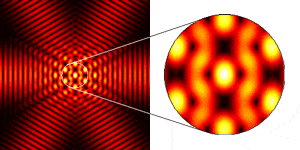Research Areas
Areas of research of the Optics Laboratory include the following:
- Quantitative Phase Imaging
- Fiber-to-Chip Interconnections
- Interference among Lidar Scanners
- Optical Fiber and Fiber Grating Characterization
- Multi-Beam Interference Lithography
- Diffractive optics
- Waveguide Optics
- Optical measurements and instrumentation
Recent Projects
- Optical Fiber Characterization
The three-dimensional index-stress distribution (3DISD) measurement method is used for determining concurrently the refractive-index distributions (RIDs) and residual-stress distributions (RSDs) in optical fibers. The method combines the quantitative-phase microscopy technique, the Brace-Kohler compensator technique, and computed tomography principles. These techniques are implemented on a common apparatus to enable concurrent characterization of the RID and the RSD. The concurrent measurements allow for the first accurate comparison of the collocated RID and RSD. Shown in the figure below are pairs of cross-sectional RIDs and RSDs in a region of Corning SMF-28 fiber exposed from one side to a focused, 500 ms duration pulse from CO2 laser.
3DISD results from Corning SMF-28 fiber exposed to CO2 laser For more information on the 3DISD method, see:M. R. Hutsel and T. K. Gaylord, “Concurrent three-dimensional characterization of the refractive-index and residual-stress distributions in optical fibers,” Appl. Opt., vol. 51, pp. 5442-5452, Aug. 1, 2012.
- Pattern-Integrated Interference Lithography
Thesis defense presentation of Dr. Matt Burrow, Pattern-Integrated Interference Lithography: Single-Exposure Formation of Photonic-Crystal Lattices with Integrated Functional Elements
- Multi-Beam-Interference Lithography
Multi-beam-interference lithography is a technique in which mulitple beams of coherent light interfere in space producing a periodic interference pattern. These periodic interference patterns along with standard lithographic processes allow for the fabrication of a multitude of micro- and nano-scale periodic structures.
The animated figures below show the instantaneous magnitude of the electric field for three different configurations of three-beam interference, differing only in the polarization of each interfering beam. The time-average intensity distribution of all three configurations exhibits p6m plane group symmetry. This intensity distribution can be used in a lithographic process to define hexagonal-lattice structures.
Interference pattern resulting in time-average intensity maxima at lattice points. 
Interference pattern resulting in time-average intensity minima at lattice points. 
Interference pattern resulting in time-average intensity maxima at lattice points. For more information on MBIL, see:
J. L. Stay and T. K. Gaylord, “Contrast in four-beam-interference lithography,” Opt. Lett., vol. 33, pp. 1434-1436, July 1, 2008.
and
J. L. Stay and T. K. Gaylord, “Three-beam-interference lithography: contrast and crystallography,” Appl. Opt., vol. 47, pp. 3221-3230, June 20, 2008.
Facilities
The Optics Laboratory, in conjuntion with the extensive resources of the
Microelectronics Research Center offers
state-of-the-art facilities that support all aspects of optics research, including:
- Mask-making
- Photo- and electron-beam lithography
- Thin-film deposition
- Reactive-ion etching
- Optical testing
- Ellipsometry
Custom-constructed facilites include:
- Ultraviolet exposure facility for fabrication of volume and surface-relief gratings
- Carbon-dioxide laser configuration for fabrication of long-period fiber gratings
- High-resolution Fourier Transform InfraRed (FTIR) spectrometer
- Polarization microscopy and differential interferece microscopy combined with spectrophotometry

